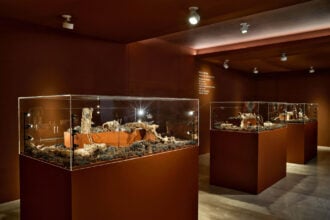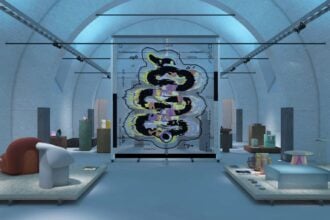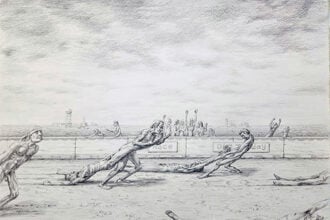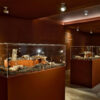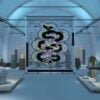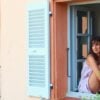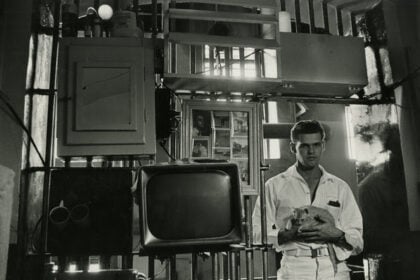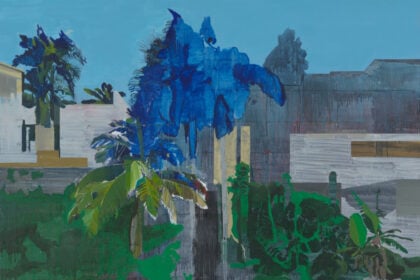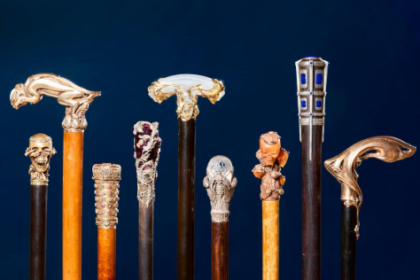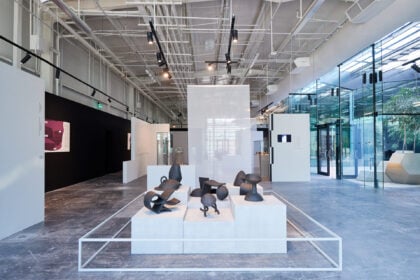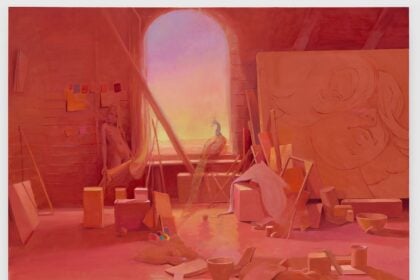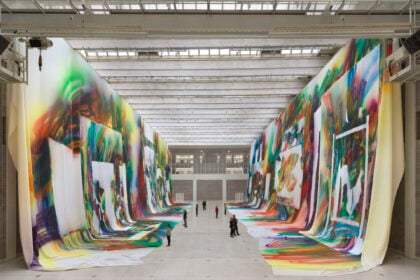New York, NY, March 28, 2024: Alice Baber (b. 1928, Charleston, IL; d. 1982, New York, NY) was an artist, curator, feminist, and world traveler, who lived as both an art world insider and an outsider, never having gained the full acknowledgement she deserved throughout her lifetime. The first largescale exhibition of Alice Baber’s work in over 40 years, Alice Baber: Reverse Infinity by Berry Campbell Gallery spotlights a long-overlooked Abstract Expressionist and foundational member of New York City’s Downtown scene. The exhibition will feature paintings by the artist created between 1960 and 1981 and will be accompanied by a 68-page catalogue authored by independent curator Dan Cameron, marking the first major piece of contemporary scholarship dedicated to Baber’s work.
Gallerists Christine Berry and Martha Campbell first learned about Baber over a decade ago while pouring over gallery rosters from the Downtown era, pursuing information about every artist listed whose name they did not know. The gallery now holds the largest cache of works from the artist and has played an instrumental role in the market’s recent surge of interest in Baber, taking her work from just $3k to nearly $700k at auction in November last year.
Featuring thinned-down oils and acrylics that act like watercolors, Baber’s work uncovers the pigments hidden in invisible energies, transliterating the movements of light and air across limitless space. While her paintings convey a spirit of unencumbered whimsy, Baber’s enduring commitment to technique and rigorous explorations of color theory are the foundations of her work. As her career progressed, her painterly investigations became more intentional, shifting from bold, free-associative watercolor forms toward a more judicious use of value in works that suggest a more complex, and perhaps even sinister, subtext.
Although many of the women of Abstract Expressionism have received belated scholarly and critical recognition in recent years, a preponderance of artists from this era remain unrecognized due to age, gender, location, ability, or perceived lack of depth. With Alice Baber: Reverse Infinity, Berry Campbell continues to correct the historical record by facilitating earnest reappraisals of artists whose work deserves serious critical engagement and positioning within art historical canons.
About Alice Baber

Alice Baber packed tremendous achievements into a life cut short when she died from cancer at age 54. Baber grew up both in Kansas, IL; and Miami, FL; where her family spent winters due to Baber’s poor health. She later recalled that all the days she remembered from her childhood “were in color.” In 1946, Baber enrolled in Lindenwood College (now Lindenwood University) in St. Charles, Missouri, and transferred to the University of Indiana, Bloomington, in 1948 where she majored in painting and journalism. Upon graduation, her teacher Alton Pickens insisted she move to New York.
In 1951, Baber traveled to France, where she studied at the École des Beaux-Arts, Fontainebleau. Subsequently, she moved to Manhattan, settling first in the Chelsea Hotel. She took an active role in the Downtown art scene, where she became part of The Club (begun in 1949), an informal salon for avant-garde artists, which held performances, panel discussions, and exhibitions in a variety of artist studios. In the mid-1960s, she became one of The Club’s most dedicated leaders along with the noted art historian Irving Sandler, reviving it at a time when it was in decline.
Along with Wilfrid Zogbaum and Elaine de Kooning, she became a founding member of the March Gallery, a Tenth Street co-operative gallery that hosted her debut solo show in 1958. It was around that time that Baber found her mature style, described by Grace Glueck for The New York Times: “Disks and puffs of pure bright color drift lyrically over a white field toward a gentle vortex.” Soon after, Baber completed a residency at the Yaddo Colony in Saratoga Springs, NY, then settled in Paris for several years, joining other North American painters, including Sam Francis, Joan Mitchell, Shirley Jaffe, and Paul Jenkins, comprising a group called École Pacifique. In 1964, she married Jenkins (whom she divorced in 1968), traveling to Japan for their joint exhibition at the Osaka Pinacotheca Museum that same year. By 1965, Baber had become affiliated with the A. M. Sachs Gallery on 57th Street, where she received critical acclaim in the press.
Throughout the 1970s, Baber organized exhibitions with the express goal of platforming her fellow women artists, including 1972’s Color Forum at the University of Texas in Austin and Color, Light, and Image at New York City’s Women’s Interart Center, where Baber became a trustee along with artists Alice Neel, Louise Nevelson, and the Feminist writer and activist Kate Millett. By this time, Baber had become active in the Feminist movement by promoting women artists, spurred by the glaring lack of women’s representation in museums. Women in the Arts, an organization that sought to remedy this neglect, organized Women Choose Women, held in January 1973 at the New York Cultural Center. The exhibition included paintings and sculpture by one hundred women selected by the women themselves. In 1974, Baber was the subject of solo shows in New Delhi and Tehran, and in 1976, she embarked on a four-month lecture and exhibition tour of 13 Latin American countries sponsored by the United States Information Agency. Baber supported herself with writing and teaching throughout her career, working as an art editor for the women’s magazine McCall’s, serving as an artist-inresidence in Albuquerque at the University of New Mexico’s Tamarind Institute, and teaching painting at The New School, UC Santa Barbara, and UC Berkeley.
Baber’s work is held in the collections of four major New York City institutions: The Solomon R.
Guggenheim Museum, The Whitney Museum of American Art, The Metropolitan Museum of Art, and The Museum of Modern Art (MoMA). Other museum collections include The Corcoran Gallery of Art (Washington, D.C.), The National Museum of Women in the Arts (Washington, D.C.), The San
Francisco Museum of Modern Art (California), The Georgia Museum of Art (Athens, Georgia), The
Worcester Art Museum (United Kingdom), The Guild Hall Museum (East Hampton, New York), The
Ball State University Museum of Art (Muncie, Indiana), The Wallrof Richartz Museum (Koln, Germany), The Neuberger Museum of Art (Purchase, New York), The Osaka National Museum of Art (Japan), The Stedelijk Museum (Amsterdam, The Netherlands), The Albertina Museum (Vienna, Austria), and theNational Gallery of Modern Art (New Delhi, India).
About Berry Campbell Gallery
Christine Berry and Martha Campbell founded Berry Campbell Gallery in 2013 in a 1000 square foot gallery in Chelsea. Now housed in a custom-built, 9,000 square-foot location on one of Chelsea’s most prestigious blocks, Berry Campbell Gallery has cemented its position among New York City galleries as a champion of artists historically marginalized due to gender, race, age, and geography.
Central to Berry and Campbell’s collective vision is a blend of scholarly dedication and enduring desire to honor their artists’ lives and work. Focusing on a selection of postwar and contemporary artists, the gallery addresses a critical gap in art history, revealing a depth within American Modernism that is only now coming to light. Notably, since its inception, Berry Campbell has elevated the profiles of postwar Abstract Expressionist women like Bernice Bing, Lynne Drexler, Perle Fine, Judith Godwin, and Ethel Schwabacher, presented alongside a growing roster of contemporary talents such as Nanette Carter, Beverly McIver, and Susan Vecsey, to name a few.
Berry Campbell’s signature ability to construct new narratives for artists lost to art history has caught the attention of the wider art world, with participation in renowned fairs like Art Basel and Frieze and artist placement within prestigious institutions worldwide. Situated at 524 W 26th Street, the gallery’s current location boasts 4,500 square feet of exhibition space, including a skylit main gallery, four smaller galleries, private viewing areas, a library, executive offices, and extensive on-site storage. For further information, visit the gallery’s website and follow on Instagram or Facebook. Alice Baber: Reverse Infinity is on view from April 18, 2024 through May 18, 2024 with an opening reception on Thursday, April 18, 2024 from 6 pm to 8 pm. Gallery hours are Tuesday through Saturday 10am – 6pm or by request.


